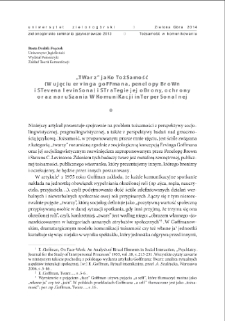Digital Library of Zielona Góra contains 9 312 digital objects
Object
Title: "Twarz" jako tożsamość (w ujęciu Ervinga Goffmana, Penelopy Brown i Stevena Levinsona) i strategie jej obrony, ochrony oraz naruszania w komunikacji interpersonalnej = "Face" as an identity (according to Hoffman, Brown and Levinson); strategies of its defense, protection and breaching in interpersonal communication
Contributor:
Steciąg, Magdalena - red. nauk. ; Bugajski, Marian - red. nauk.
Group publication title:
Abstract_pl:
Abstract:
The base thesis of this article is the assumption that the actions we undertake in interpersonal communication are determined by strategies attributable to "the face" - both ours and ours` interlocutors. The term "face" is understood here after Erving Goffman theories - as a social image, "the positive social value a person effectively claims for himself by the line others assume he has taken during a particular contact", and it is considered as a type of social or public identity. ; In the course of communicative encounters with another human being the individual presents said public identity, defends it against the actions of others and also performs the construction of its face, often using strategies that in turn breach faces of the interlocutors. It is the category of face (along with its two aspects ? positive and negative) that designates our verbal and non-verbal communication strategies: polite, autorepresentative, manipulative and others.
Publisher:
Zielona Góra: Oficyna Wydawnicza Uniwersytetu Zielonogórskiego
Format:
Resource Identifier:
DOI:
Pages:
Source:
Zielonogórskie Seminaria Językoznawcze 2013
Language:
Rights:
Biblioteka Uniwersytetu Zielonogórskiego
Object collections:
- Repository > Faculties > Faculty of Humanities
- Repository > Types of work > Chapters in books
- Repository > Scientific journals and UZ publishing series > Zielonogórskie Seminaria Językoznawcze
Last modified:
Nov 2, 2023
In our library since:
Dec 12, 2022
Number of object content hits:
773
All available object's versions:
https://zbc.uz.zgora.pl/repozytorium/publication/73932
Show description in RDF format:
Show description in OAI-PMH format:
Objects Similar
Steciąg, Magdalena Bugajski, Marian (1949 -) Steciąg, Magdalena - red. nauk. Bugajski, Marian - red. nauk.
Bugajski, Marian (1949 -) Steciąg, Magdalena - red. nauk. Bugajski, Marian - red. nauk.
Uździcka, Marzanna Steciąg, Magdalena - red. nauk. Bugajski, Marian - red. nauk.
Szagun, Dorota Steciąg, Magdalena - red. nauk. Bugajski, Marian - red. nauk.
Jurewicz-Nowak, Magdalena Steciąg, Magdalena - red. nauk. Bugajski, Marian - red. nauk.
Pałucka-Czerniak, Iwona Steciąg, Magdalena - red. nauk. Bugajski, Marian - red. nauk.
Borkowski, Igor Steciąg, Magdalena - red. nauk. Bugajski, Marian - red. nauk.
Majdańska-Wachowicz, Urszula Steciąg, Magdalena - red. nauk. Bugajski, Marian - red. nauk.

